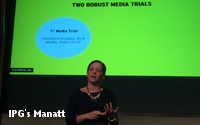 IPG
Media Lab Vice President-Consumer Research Strategy Kara Manatt presented some counterintuitive -- at least until she explained it -- research findings on “viewability” during a keynote
presentation at the Programmatic Insider Summit in Lake Tahoe this morning.
IPG
Media Lab Vice President-Consumer Research Strategy Kara Manatt presented some counterintuitive -- at least until she explained it -- research findings on “viewability” during a keynote
presentation at the Programmatic Insider Summit in Lake Tahoe this morning.
The presentation, which covered two recent Lab studies, was intended to put some science
behind the industry’s current standards for defining a viewable impression. Those standards, created by the Media Rating Council, she said were designed to define a minimum opportunity for
people to view and impression, but not necessarily what criteria leads to the most effective and efficient viewable impressions.
Among other things, the Lab’s study found that
more campaigns falling below the MRC’s standard -- that 50% of an ad’s pixels must be viewable for at least one second for static ad and two seconds for a video ad -- actually were more
effective than ads that matched that criteria exactly.
Specifically, the Lab found that while 2% of ads matching the MRC’s criteria exactly had an “impact,” 16% of
those exceeding it and 6% of those falling below it, worked.
Why would ads falling below the MRC’s criteria work so well? Manatt explained it’s because there are two
dimensions in the MRC’s criteria -- time in-view, and the percentage of pixels in view. And the real finding is that one of those dimensions -- time in-view -- is more important than the
other.
She explained that an ad that had only 40% of its pixels in view, but was on the screen for a longer duration, would have a greater impact than ads fully in view
but had less time in view, because the longer an ad is in view, the more effective it is.
“People need the time to see the branding, to internalize it and to remember
it,” she explained, adding, “Time in-view is a much more important variable than percent in-view.”
Manatt said it wasn’t the Lab’s
intention to challenge the MRC’s definition, merely to put some dimensions around the standard so that agencies and brands could measure the relative effectiveness of their viewable
impressions.
Two tips she offered to ensure ads less-than-fully-viewable ads have an impact are to ensure the brand’s logo is near the top, and that the audio is on. Running in
less cluttered ad environments is also a positive factor.